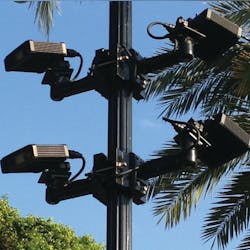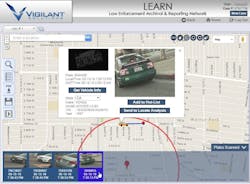How LPR Helps the Doral Police Department
Set within popular Miami Dade County, Florida sits the humble city of Doral. One could say it’s the intersection between the Miami International Airport, the Port of Miami and three major highways. This busy commercial city holds a regular population of 64,000 but by day, according to Police Captain Arango of the Doral Police Department, that population explodes to around 200,000.
The City of Doral Police Department is relatively new. Established in 2008, one of the missions of the department was to develop a license plate reader system that would help them not only with statistical information but with a focus on crime prevention and crime solution. They are working on eventually having all the perimeter intersections outfitted with license plate recognition (LPR) as well as major points throughout the city. At current, Arango explains they are now up to 22 intersections with 6 or more coming later this year. For those counting, that’s over 100 cameras.
The City of Doral PD began implementing Vigilant’s LPR solution in June 2015. According to the award announcement, “the department gathers more than 8,000 license plate detections per month, 2% of which result in ‘hits’ related to crimes such as stolen vehicles, missing persons, Amber Alerts, fugitives, and homicides.” Scanned plates are run through the Vigilant Law Enforcement Archival Reporting Network (LEARN) software system. Captured data is automatically compared to hot lists and against NCIC and FCIC databases. Dispatchers verify every hit, double check the image and run the tag themselves. In an effort to limit driver distractions, the PD’s patrol vehicles do not have mobile LPR cameras—save one. They primarily use fixed cameras.
Also relatively young, Vigilant Solutions started just about 12 years ago, out of Livermore, Calif. as an image analytics company. That mindset hasn’t changed. Today, they see themselves as more of a software and data company instead of only selling public safety hardware. To date, they offer LPR solutions, facial recognition technologies and they recently launched a ballistics analysis program earlier this year.
Tech aids investigation
With his experience as a detective himself, Tom Joyce, a retired member of the NYPD in the rank of Lieutenant Commander of Detectives and Vice President of Business Development at Vigilant Solutions, understands that a lot of stolen vehicles are used for transportation to commit other crimes. Using Doral’s placement of cameras around its perimeter, one could argue that they could be basically preventing potential crimes by capturing them at the gate. “We don’t know what crime they would have ever committed…but over a period of time and you’ve stopped hundreds and hundreds of stolen vehicles, there is a percentage of those that were going to commit other crimes and victimize other people,” says Joyce.
“This year, we’re 22% below last year in our crime rate,” says Arango. Unfortunately, how much of that is attributed to LPR technology is tough to say. You can’t argue with results though. Last year, for example, he explains that LPR was able to capture the plate of a serial burglar in a different part of the city and connect him to a number of the unsolved cases. Because of the hit, detectives were able to run that plate in the system to discover where else that vehicle was and if it was also seen in any areas where the burglaries were committed. “Although that wasn’t enough to go and get the guy...it was the first domino to start falling,” says Arango.
Investigators were able to begin surveillance and set alerts on the LPR system. Soon enough, he came back into the area, triggered the system, detectives were dispatched and was tracked down. According to Arango, with this one arrest, the PD was able to clear four or five other burglaries.
There were 20 or so others. However, the burglaries stopped. The assumption is they caught the right guy.
Assuming perfect connectivity on every piece of technology in the system, Joyce explains that LPR alerts should take roughly 2 to 3 seconds. That’s from the camera, to the hotlists, and pinging the dispatcher’s computer or a mobile terminal with a notification software from Vigilant called Target Alert Service in under the amount of time you read this paragraph.
Co-location analytics can also help investigations when dealing with clever criminals—or at least those who think they are. Doral has seen several incidents where suspects put rags over their plate or just take the plate off. Historical data captured in Vigilant’s software allows investigators to review other intersections before and after the crime, especially if there’s something distinctive about the vehicle. Arango explains that “if it’s a white pick-up…you don’t have much. If it’s a white pick-up truck that had a tarp in the back and a brown box…they might have covered the tag during the time of the crime, but we might actually have that same car at another intersection and capture [it] there.”
Partial tags and wildcard searches aren’t a dead-end. Investigators using LPR software like Vigilant’s LEARN system, are able to query the database with partial plate searches limiting the results within a specific time period. Further, it offers a second choice in case that 3 was actually a faded 8.
With Vigilant’s analytical interests, its software is able to crunch, cluster, score and suggest to give directional pointers to investigators to help make the correct decisions. “We’re just trying to make it quicker and easier for law enforcement to identify and locate the bad people and get them at the right place at the right location as fast as possible so that other people are not victimized,” says Joyce. That means the investigator’s scope of the investigation is much wider with more people spoken to—helping make investigations that much more efficient.
Editor’s Note: At the time of publication, Captain Carlos Arango has moved to a different police department and is no longer with the Doral PD.
About the Author

Jonathan Kozlowski
Jonathan Kozlowski was with Officer.com, Law Enforcement Technology, and Law Enforcement Product News from August 2006 to 2020.
As former Managing Editor for Officer Media Group, he brought a dedicated focus to the production of the print publications and management of the Officer.com online product and company directory. You can connect with Jonathan through LinkedIn.
Jonathan participated as a judge for the 2019 and 2020 FOLIO: Eddie & Ozzie Awards. In 2012, he received an APEX Award of Excellence in the Technology & Science Writing category for his article on unmanned aerial vehicles (UAVs) in police work, aptly titled "No Runway Needed".

